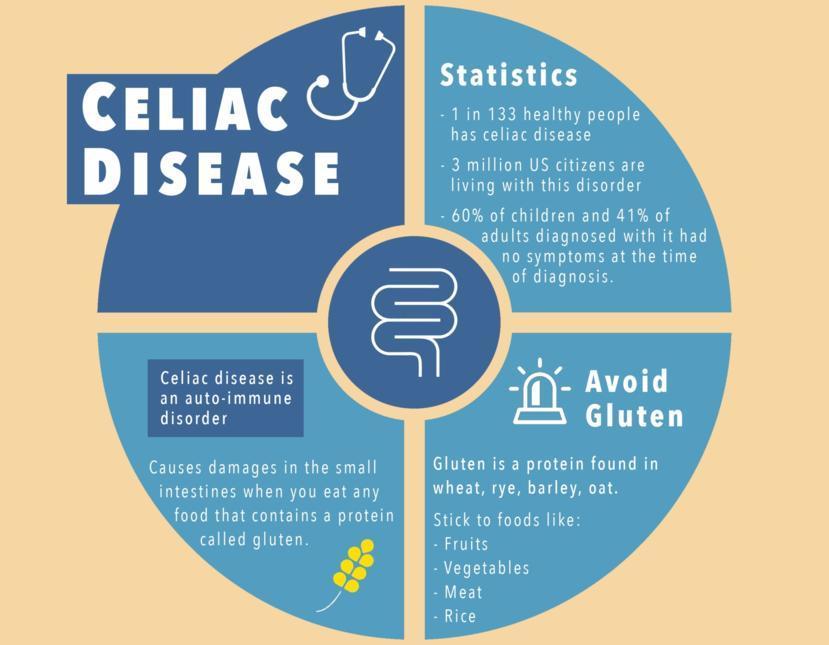Discover the secrets to successfully managing Celiac Disease with these expert tips and best practices for a healthier life.
Table of Contents
Introduction to Celiac Disease
In this section, we will delve into what celiac disease is and why understanding it is crucial for your health.
What is Celiac Disease?
Celiac disease is an autoimmune disorder. This means that your body mistakenly attacks healthy tissues, thinking they are harmful invaders. When someone with celiac disease eats gluten, a protein found in wheat, barley, and rye, their immune system goes into overdrive, damaging the lining of their small intestine.
Why Does Celiac Disease Matter?
Understanding celiac disease is vital because it can cause a host of health issues if left unchecked. By avoiding gluten and following a strict gluten-free diet, individuals with celiac disease can maintain their digestive health and lead a happier, healthier life.
Understanding Gluten
In this section, we will explore what gluten is and how it impacts people with celiac disease.
What is Gluten?
Gluten is a protein found in grains like wheat, barley, and rye. It’s what makes dough stretchy and gives bread its fluffy texture.
Gluten’s Effect on the Body
For people with celiac disease or gluten intolerance, gluten can cause problems. When someone with celiac disease eats gluten, their immune system mistakenly attacks the lining of their intestine, which can lead to digestive issues and other symptoms.
Identifying Celiac Symptoms
When someone has celiac disease, it can make them feel sick. Let’s take a look at how to recognize the signs that someone might have this condition.

Image courtesy of www.pinterest.com via Google Images
Common Signs of Celiac Disease
If you have celiac disease, you might experience symptoms like stomach pain, bloating, diarrhea, or feeling tired all the time. Some people also get headaches, skin rashes, or have a hard time gaining weight. Pay attention to how your body feels and tell a grown-up if something doesn’t seem right.
Why These Symptoms Happen
When someone with celiac disease eats gluten, their body has a hard time digesting it. This can cause the immune system, which is like the body’s defense mechanism, to mistakenly attack the intestines. As a result, the body can’t absorb all the nutrients it needs, leading to symptoms like stomach problems and feeling tired.
The Importance of Diagnosis
Being diagnosed with celiac disease is a crucial step in managing this condition and keeping your digestive health in check. Diagnosis is the process of finding out if someone has celiac disease or not.
How Doctors Test for Celiac Disease
When you visit the doctor to find out if you have celiac disease, they will perform a simple blood test. This test looks for certain antibodies in your blood that are present in people with celiac disease. If the blood test shows indicators of celiac disease, your doctor may recommend a biopsy of your small intestine to confirm the diagnosis.
What Happens After Diagnosis?
If the blood test and biopsy confirm that you have celiac disease, don’t worry! You’re not alone in dealing with this condition. Your doctor will work with you to create a treatment plan, typically involving a gluten-free diet, to manage your symptoms and keep you healthy.
Starting a Gluten-Free Diet
If you’re starting a gluten-free diet, it’s important to know which foods to steer clear of. Gluten is found in grains like wheat, barley, and rye, so things like bread, pasta, and baked goods usually contain gluten. Pay attention to labels and look for words like “wheat,” “barley,” or “rye” in the ingredient list. It’s also a good idea to avoid processed foods that may have hidden sources of gluten.

Image courtesy of www.mdpi.com via Google Images
Finding Gluten-Free Options
Don’t worry, there are plenty of delicious foods that are gluten-free! Fruits, vegetables, meats, and dairy products are all safe to eat. Rice, quinoa, and oats can also be part of a gluten-free diet if they are labeled gluten-free. When shopping, look for products with a “gluten-free” label to make sure they’re safe for you to enjoy. And remember, there are also gluten-free versions of many of your favorite foods like pasta and pizza crust, so you don’t have to miss out on delicious meals!
| Best Practice | Description |
|---|---|
| Consult with a Dietitian | A dietitian can help create a gluten-free meal plan and provide guidance on proper nutrition for managing celiac disease. |
| Read Food Labels Carefully | Learn how to identify gluten-containing ingredients in food labels to avoid accidentally consuming gluten. |
| Avoid Cross-Contamination | Use separate cooking utensils, cutting boards, and cookware to prevent gluten from coming into contact with gluten-free food. |
| Communicate with Restaurants | Inform restaurants about your dietary restrictions and ask about gluten-free options to prevent accidental gluten exposure. |
| Stay Educated | Keep up-to-date with the latest research and recommendations for managing celiac disease to ensure optimal health outcomes. |
Living with Celiac Disease
Living with celiac disease means making some changes to the way you eat, but it doesn’t have to be difficult. With a few adjustments, you can still enjoy delicious food while taking care of your digestive health.
Tips for School and Friends
When it comes to school lunches, it’s essential to pack meals that are gluten-free. Talk to your parents about making sure your lunch doesn’t have any gluten-containing ingredients. Don’t forget to let your friends know about your condition so they can support you and understand why you need to eat special foods.
Dealing with Social Situations
Going to parties or gatherings where food is served may feel overwhelming at first, but with a little preparation, you can still have fun. Always remember to bring your own gluten-free snacks or treats in case there aren’t any options available. You can also politely ask the host in advance if they can provide gluten-free alternatives.
Cooking and Shopping Gluten-Free
When cooking gluten-free at home, it’s important to be mindful of the ingredients you use. Look for foods that are naturally gluten-free, like fruits, vegetables, meats, and dairy products. You can also swap out regular flour for gluten-free alternatives like almond flour, coconut flour, or rice flour in your baking recipes. Always check labels to make sure the products you’re using are free of gluten.
Shopping for Gluten-Free Foods
When shopping for gluten-free foods, keep an eye out for labels that indicate the product is gluten-free. Look for certifications like the Certified Gluten-Free label to ensure the product meets strict gluten-free standards. Be cautious of hidden sources of gluten in packaged foods like sauces, dressings, and seasoning mixes. It’s always best to double-check the ingredients list to avoid any potential gluten exposure.
Understanding Cross-Contamination
When dealing with celiac disease and following a gluten-free diet, understanding cross-contamination is crucial to maintaining good health. Let’s dive into what cross-contamination is and how to prevent it.

Image courtesy of www.celiac.ca via Google Images
What is Cross-Contamination?
Cross-contamination happens when gluten-containing foods come into contact with gluten-free foods, causing the latter to become unsafe for individuals with celiac disease. This can occur through shared utensils, cutting boards, toasters, or even in cooking oils.
Preventing Cross-Contamination
To prevent cross-contamination at home, it’s essential to have separate kitchen tools and equipment for gluten-free cooking. This includes using designated cutting boards, toasters, and even condiment containers to avoid any gluten particles from contaminating your food.
When dining out, it’s important to communicate your dietary needs clearly to restaurant staff. Ask about their procedures for preventing cross-contamination and ensure that your meal is prepared safely in a gluten-free environment.
By being vigilant and proactive about preventing cross-contamination, you can enjoy your gluten-free meals with peace of mind and protect your digestive health.
Support and Resources
If you have celiac disease, you might feel like you’re the only one dealing with it. But there are actually many other kids who understand exactly what you’re going through. That’s why joining a support group can be a great idea. Support groups are places where people with celiac disease come together to share their experiences, tips, and tricks for managing the condition. You can find support groups online or even in your local community. Meeting others who are going through the same things can help you feel less alone and more empowered to manage your celiac disease.
Educational Resources
Learning more about celiac disease and how to live a healthy, gluten-free lifestyle is important. There are plenty of resources out there to help you understand your condition better. You can ask your doctor for recommended books or websites that are kid-friendly and full of useful information. By educating yourself about celiac disease, you can become your own best advocate. Knowledge is power when it comes to managing your health, so don’t be afraid to explore different resources to learn as much as you can.
Concluding Thoughts
Throughout this blog post, we’ve explored essential information about celiac disease and how to manage it effectively. By understanding the impact of this autoimmune disorder, identifying common symptoms, receiving a proper diagnosis, and initiating a gluten-free diet, individuals can significantly improve their digestive health and overall well-being.

Image courtesy of www.findatopdoc.com via Google Images
Living with celiac disease may pose challenges, but with the right knowledge and support, navigating daily life can become more manageable. From handling school meals and social gatherings to cooking and shopping for gluten-free foods, there are strategies to ensure a smooth transition to a gluten-free lifestyle.
Remember, maintaining a gluten-free diet is key to managing celiac disease and preventing uncomfortable symptoms. By being vigilant about avoiding gluten-containing foods and understanding the risks of cross-contamination, individuals can protect their health and enjoy a better quality of life.
Lastly, finding support from others who share similar experiences and accessing educational resources can provide valuable guidance and reassurance. By seeking out support groups and informative materials, individuals can feel empowered and informed on their journey to effectively managing celiac disease.
FAQs
Can I ever eat gluten again?
If you have celiac disease, it’s important to remember that gluten can make you sick. It’s like a superhero with a kryptonite allergy – you need to stay away from it to feel your best. Eating gluten can damage your insides over time. So, unfortunately, if you have celiac disease, you will need to stick to a gluten-free diet to keep yourself healthy and strong.
What happens if I accidentally eat gluten?
If you accidentally eat gluten, you may start to feel sick. Your stomach might hurt, you could have a headache, or you might feel very tired. It’s your body’s way of telling you that it didn’t like what you ate. Don’t worry! Drink plenty of water to help flush it out of your system. And make sure to eat safe and gluten-free foods to help you feel better soon.





